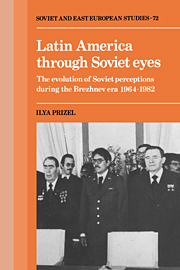 Latin America through Soviet Eyes
Latin America through Soviet Eyes There are several pertinent conclusions to be drawn from the evolution of Soviet perceptions of Latin America during the Brezhnev era. Perhaps the most striking aspect of this evolution was the dramatic improvement in the quality and sophistication of Soviet analysis of the continent. Between 1917 and 1969 (the year Latinskaia Amerika was launched) most Soviet analysis resembled the caricature by the Colombian primitivist master, Botero, that depicted Latin America as a hemisphere made up of poor campesinos dominated by the obese church and military and comprador elites, which in turn acted as marionettes for US interests. This rather simplistic Soviet perception was further trivialized by the almost universal tendency to view all of Latin America as an essentially undifferentiated block of countries, from the Rio Grande to Patagonia. Only occasional attention was paid to the fact that, despite some cultural and linguistic commonalities, Latin America comprised a set of distinct countries with very different social, political, and economic structures.
By the mid-1970s, and particularly after the victory of the FSLN in Nicaragua, Soviet analysis of Latin America ceased to treat the hemisphere as a unitary body. Instead, the scholarly community in the USSR began to divide the hemisphere into various subgroupings, such as the Southern Cone, the Andean countries, Central America, and the Caribbean and Mexico. This new, non-monolithic view of the area led to far more sophisticated expectations and policies vis-à-vis Latin America.
To save this book to your Kindle, first ensure [email protected] is added to your Approved Personal Document E-mail List under your Personal Document Settings on the Manage Your Content and Devices page of your Amazon account. Then enter the ‘name’ part of your Kindle email address below. Find out more about saving to your Kindle.
Note you can select to save to either the @free.kindle.com or @kindle.com variations. ‘@free.kindle.com’ emails are free but can only be saved to your device when it is connected to wi-fi. ‘@kindle.com’ emails can be delivered even when you are not connected to wi-fi, but note that service fees apply.
Find out more about the Kindle Personal Document Service.
To save content items to your account, please confirm that you agree to abide by our usage policies. If this is the first time you use this feature, you will be asked to authorise Cambridge Core to connect with your account. Find out more about saving content to Dropbox.
To save content items to your account, please confirm that you agree to abide by our usage policies. If this is the first time you use this feature, you will be asked to authorise Cambridge Core to connect with your account. Find out more about saving content to Google Drive.